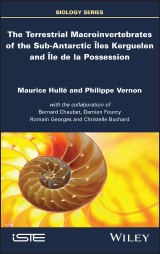Details

The Terrestrial Macroinvertebrates of the Sub-Antarctic Iles Kerguelen and Ile de la Possession
1. Aufl.
|
139,99 € |
|
| Verlag: | Wiley |
| Format: | EPUB |
| Veröffentl.: | 22.07.2021 |
| ISBN/EAN: | 9781119851219 |
| Sprache: | englisch |
| Anzahl Seiten: | 240 |
DRM-geschütztes eBook, Sie benötigen z.B. Adobe Digital Editions und eine Adobe ID zum Lesen.
Beschreibungen
The sub-Antarctic islands are remote and isolated environments with original flora and fauna composed of a few species that are highly adapted to cold oceanic conditions. Their peculiar naturalness makes these ecosystems intrinsically fragile.<br /><br />This book focuses on terrestrial ecosystems and, in particular, on invertebrates - earthworms, mollusks, spiders and insects - that inhabit the French sub-Antarctic islands of the South Indian Ocean. All native and introduced species are presented in the form of individual fact sheets, which include the main identification criteria, geographical distribution and principal ecological traits. Numerous summary tables, distribution maps of introduced species, and a discussion on the originality and vulnerability of this fauna are also included.<br /><br />The Terrestrial Macroinvertebrates of the Sub-Antarctic Iles Kerguelen and Ile de la Possession is based on an expansive literature base, as well as on observations and photographs taken as part of a research program funded by the French Polar Institute Paul-Emile Victor (IPEV). The book also gives an important part to the history of the discoveries of the different species, as well as current conservation issues.
<p>Foreword 1 ix</p> <p>Foreword 2 xiii</p> <p>Acknowledgements xvii</p> <p>Introduction xix</p> <p><b>Chapter 1. General Presentation</b> 1</p> <p>1.1. Physical environment 1</p> <p>1.1.1. Location and size 1</p> <p>1.1.2. Topography 2</p> <p>1.1.3. Climate 5</p> <p>1.2. Landscapes 7</p> <p>1.2.1. Sea-edge 7</p> <p>1.2.2. Grasslands 9</p> <p>1.2.3. Wetlands and mires 10</p> <p>1.2.4. Fellfield and rocks 10</p> <p>1.2.5. Buildings and huts 15</p> <p>1.3. Human occupancy 15</p> <p>1.4. Natural history and history of species discovery 16</p> <p>1.5. Current research on invertebrates 19</p> <p>1.6. Nature reserve and access areas 21</p> <p>1.7. The terrestrial macroinvertebrates 21</p> <p><b>Chapter 2. Annelida – Clitellata </b>25</p> <p>2.1. Order: Crassiclitellata 26</p> <p>2.1.1. Family: Acanthodrilidae 26</p> <p>2.1.2. Family: Lumbricidae 29</p> <p><b>Chapter 3. Mollusca – Gastropoda </b>35</p> <p>3.1. Order: Stylommatophora 35</p> <p>3.1.1. Family: Charopidae 35</p> <p>3.1.2. Family: Agriolimacidae 36</p> <p><b>Chapter 4. Arthropoda – Arachnida </b>39</p> <p>4.1. Order: Araneae 39</p> <p>4.1.1. Family: Anapidae 39</p> <p>4.1.2. Family: Desidae 41</p> <p>4.1.3. Family: Hahniidae 45</p> <p>4.1.4. Family: Linyphiidae 46</p> <p>4.1.5. Family: Agelenidae 52</p> <p>4.1.6. Family: Pholcidae 53</p> <p>4.1.7. Family: Theridiidae 55</p> <p>4.2. Order: Opiliones 57</p> <p>4.2.1. Family: Triaenonychidae 57</p> <p>4.3. Order: Pseudoscorpiones 58</p> <p>4.3.1. Family: Chthoniidae 58</p> <p><b>Chapter 5. Arthropoda – Insecta </b>61</p> <p>5.1. Order: Coleoptera 62</p> <p>5.1.1. Family: Curculionidae 63</p> <p>5.1.2. Family: Hydraenidae 86</p> <p>5.1.3. Family: Latridiidae 87</p> <p>5.1.4. Family: Ptinidae 90</p> <p>5.1.5. Family: Staphylinidae 91</p> <p>5.1.6. Family: Trechidae 94</p> <p>5.2. Order: Diptera 99</p> <p>5.2.1. Family: Anthomyiidae 100</p> <p>5.2.2. Family: Calliphoridae 102</p> <p>5.2.3. Family: Canacidae 103</p> <p>5.2.4. Family: Carnidae 106</p> <p>5.2.5. Family: Chironomidae 107</p> <p>5.2.6. Family: Ephydridae 116</p> <p>5.2.7. Family: Helcomyzidae 117</p> <p>5.2.8. Family: Keroplatidae 118</p> <p>5.2.9. Family: Micropezidae 119</p> <p>5.2.10. Family: Psychodidae 120</p> <p>5.2.11. Family: Scatopsidae 122</p> <p>5.2.12. Family: Sciaridae 123</p> <p>5.2.13. Family: Simuliidae 125</p> <p>5.2.14. Family: Sphaeroceridae 127</p> <p>5.2.15. Family: Trichoceridae 132</p> <p>5.3. Order: Hemiptera 134</p> <p>5.3.1. Family: Aphididae 134</p> <p>5.3.2. Family: Enicocephalidae 143</p> <p>5.4. Order: Hymenoptera 144</p> <p>5.4.1. Family: Figitidae 145</p> <p>5.5. Order: Lepidoptera 146</p> <p>5.5.1. Family: Plutellidae 146</p> <p>5.5.2. Family: Tineidae 148</p> <p>5.5.3. Transient moths and butterflies 150</p> <p>5.6. Order: Psocoptera 152</p> <p>5.6.1. Family: Elipsocidae 152</p> <p>5.6.2. Family: Trogiidae 154</p> <p>5.7. Order: Thysanoptera 156</p> <p>5.7.1. Family: Thripidae 156</p> <p><b>Chapter 6. Originality and Fragility of Invertebrate Fauna </b>159</p> <p>6.1. Biogeography and adaptations 159</p> <p>6.1.1. Biogeography 159</p> <p>6.1.2. Taxonomic and functional disharmony 161</p> <p>6.1.3. Biological adaptations 163</p> <p>6.2. Biological invasions and climate change 165</p> <p>Appendix 175</p> <p>References 183</p> <p>Index 201</p>
<b>Maurice Hulle</b> is a senior researcher who has studied the ecology of insect pests, specifically aphids. Since 2000, he has been interested in polar ecosystems, particularly the ecology of introduced species and their adaptation to environmental conditions.<br /><b>Philippe Vernon</b> received his PhD in 1981 from the University of Rennes 1, France, studying the ecology of sub-Antarctic flightless flies. His focus is on invertebrate ecophysiology and he is currently interested in adaptation to changing environments along elevational gradients.













